If you carry a balance on your credit card regularly, a balance transfer credit card can be a useful tool to save on interest charges and pay off debt quickly. High interest rates can keep you from making progress financially.
Still, by moving your current balance to a card with a 0% introductory APR or a lower regular interest rate, you can save money and better manage your payments.
We have reviewed some of the top deals out there for you and made a list of the top five balance transfer credit card companies for 2025. The companies were chosen based on criteria such as introductory APR promotions, balance transfer fees, regular interest rates, and other benefits.
Let’s take a closer look at the top five balance transfer credit card issuers of 2025 and what they have to offer.
Summary Table (TLDR)
Top 5 Balance Transfer Credit Card Issuers for 2025
| Serial Number | Credit Card Issuers | Best Known For | Credit Cards |
|---|---|---|---|
| 1. | CitiBank | Long 0% APR periods with no late fees | Citi Simplicity Card, Citi Diamond Preferred Card, Citi Custom Cash Card, Citi Double Cash, Citi Reward + Card |
| 2. | Chase Bank | Rewards & multiple balance transfer options | Chase Slate Edge Credit Card, Chase Freedom Flex, Chase Freedom Unlimited |
| 3. | Bank of America | Competitive intro APR with no annual fee | Bank of America® Unlimited Cash Rewards, Bank of America® Customized Cash Rewards, Bank Americard |
| 4. | U.S. Bank | Extended 0% APR periods | U.S. Bank Shield™ Visa® Card, U.S. Bank Cash+® Visa Signature® Card, U.S. Bank Altitude® Go Visa Signature® Card |
| 5. | Wells Fargo | Long 0% APR offers with cellphone protection. | Wells Fargo Reflect® Card, Wells Fargo Active Cash® Card |
Best Balance Transfer Credit Cards with Low-Interest Rates in the USA for 2025
CitiBank Balance Transfer Credit Cards
Citi provides some of the most extended 0% APR terms, sometimes as long as 21 months. Their balance transfer rates are competitive, and they are low-cost options. Citi cards have low regular APRs following the intro period.
Excellent digital features and great customer service provide a good user experience. Good for those who want to save on interest over a longer period.
1. Citi Simplicity Card
Best for those who want a long 0% intro APR period and no late fees. It offers a 0% intro APR on balance transfers for 21 months, followed by a variable APR. No annual fee and no penalty APR make it ideal for balance transfers and avoiding fees.
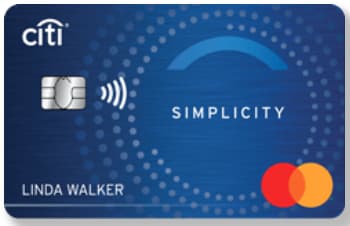
- Issuer – Citibank
- Payment Gateway – MasterCard
- Annual Fee – $0
- Credit Score – Good-Excellent
- Intro APR – 0% for 21 months
- Regular APR – 19.24%–29.24%
- Balance Transfer APR – 0 for 21 months and then regular (19.24%–29.24%)
- Cash Advance Fee – 5% or $10
- Sign-up Bonus – N/A
- International Transaction Fee – 3%
- Best For – Balance Carriers, Budget-Conscious
2. Citi Diamond Preferred Card
Designed for those looking for a long 0% APR period on purchases and balance transfers. It provides 21 months of 0% APR on balance transfers, making it an excellent choice for managing existing debt. No annual fee, but it lacks rewards programs.
- Issuer – Citibank
- Payment Gateway – MasterCard
- Annual Fee – 3%
- Credit Score – $0
- Intro APR – 0% for 21 months
- Regular APR – 18.24%-29.24%
- Balance Transfer APR – 0% for 21 months, then regular 18.24%-29.24%
- Cash Advance Fee – 0% intro APR for 21 months on purchases & transfers
- Sign-up Bonus – N/A
- International Transaction Fee – 0% for 21 months, after that, 3%
- Best For – Balance Carriers, Students
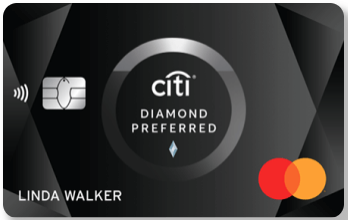
3. Citi Custom Cash Card
A great option for maximizing cash back on everyday spending. It offers 5% cash back on your top spending category (up to $500 monthly), automatically adjusting to your spending habits. Perfect for users who want rewards without tracking categories.
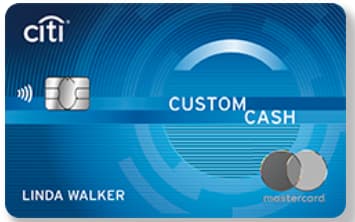
- Issuer – Citibank
- Payment Gateway – MasterCard
- Annual Fee – $0
- Credit Score – Good-Excellent
- Intro APR – 0% for 15 months
- Regular APR – 19.24%–29.24%
- Balance Transfer APR – 0% for 15 months, then regular 19.24%–29.24%
- Cash Advance Fee – 5% or $10, whichever is greater
- Sign-up Bonus – $200 cash back after $1,500 spent in 3 months
- International Transaction Fee – 3%
- Best For – Everyday Users, High Spenders
4. Citi Double Cash Card
Ideal for those who want simple, flat-rate cashback. Earn 2% cashback on all purchases (1% when you buy and 1% when you pay off the balance). It also features an 18-month 0% APR on balance transfers, making it a great dual-purpose card.
- Issuer – Citibank
- Payment Gateway – MasterCard
- Annual Fee – $0
- Credit Score – Good-Excellent
- Intro APR – 0% intro APR for the first 18 months
- Regular APR – 19.24%–29.24%
- Balance Transfer APR – 0% for 18 months, then regular 19.24%–29.24%
- Cash Advance Fee – 5% or $10, whichever is greater
- Sign-up Bonus – N/A
- International Transaction Fee – 3%
- Best For – Everyday Users, Budget-Conscious
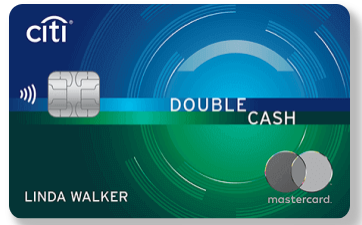
5. Citi Reward+@ Card
Best for small purchases due to its unique round-up feature, which rounds up points on every transaction to the nearest 10 points. Earn 2X points on groceries and gas (up to $6,000 per year) and 1X on other purchases.
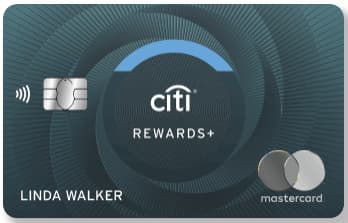
- Issuer – Citibank
- Payment Gateway – MasterCard
- Annual Fee – $0
- Credit Score – Good-Excellent
- Intro APR – 0% for 15 months
- Regular APR – 19.24%–29.24%
- Balance Transfer APR – 0% for 15 months, then regular, 19.24%–29.24%
- Cash Advance Fee – 5% or $10, whichever is greater
- Sign-up Bonus – 20,000 points after $1,500 spent in 3 months
- International Transaction Fee – 3%
- Best For – Everyday Users, Students
Chase Balance Transfer Credit Cards
Chase offers 0% APR balance transfer deals with bonus cashback rewards. They usually charge low or no annual fees, which are inexpensive.
Chase’s fraud protection offers safety for purchases. Mobile banking features provide easy payment management. A perfect option for people who desire to save on the internet while gaining rewards.
1. Chase Slate Edge Credit Card
A credit-building card designed to help with balance transfers and responsible credit use. It offers a 0% intro APR for 18 months on balance transfers and purchases, with the potential to lower your APR over time based on responsible usage.
- Issuer – Chase
- Payment Gateway – Visa
- Annual Fee – $0
- Credit Score – Limited/ No Credit
- Intro APR – 0% intro APR on purchases and balance transfer for 6 months; after that, variable APR of 14.99% – 24.74%.
- Regular APR – 20.49% – 29.24% Variable
- Balance Transfer APR – 0% Intro APR on Balance Transfers for 18 months; then 20.49% – 29.24% Variable
- Cash Advance Fee – N/A
- International Transaction Fee – 3% of each transaction in U.S. dollars.
- Sign-up Bonus – A $50 bonus after purchasing within the first 3 months of account opening.
- Best For – Credit Builder, Students
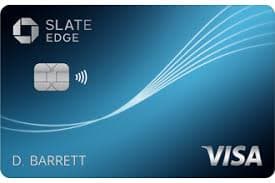
2. Chase Freedom Flex Credit Card
Best for earning rotating category cash back. Earn 5% back on quarterly rotating categories (up to $1,500), 3% on dining and drugstores, and 1% on all other purchases. It’s a great choice for maximizing rewards.
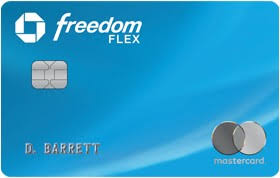
- Issuer – Chase
- Payment Gateway – Visa
- Annual Fee – $550
- Credit Score – Excellent
- Intro APR – 0% for 18 months
- Regular APR – 22.24%–29.24%
- Balance Transfer APR – 0% Intro APR for 18 Months, after that, Regular APR
- Cash Advance Fee – 5% or $10, whichever is greater
- International Transaction Fee – No Foreign Transaction Fee
- Sign-up Bonus – 60,000 points after $4,000 spent in 3 months
- Best For – Frequent Travelers, Luxury Travelers
3. Chase Freedom Unlimited
A solid option for everyday spending. Earn unlimited 1.5% cash back on all purchases, with bonus rewards on travel (5%), dining (3%), and drugstores (3%). It’s best for those who want straightforward rewards without category tracking.
- Issuer – Chase
- Payment Gateway – Visa
- Annual Fee – $0
- Credit Score – Good-Excellent
- Intro APR – 0% for 15 months
- Regular APR – 20.24%–28.99%
- Balance Transfer APR – 0% for the first 18 months, then a variable APR of 20.24%–28.99%
- Cash Advance Fee – 5% or $10
- Sign-up Bonus – $200 after $500 spent in 3 months
- International Transaction Fee – 3%
- Best For – General Consumers
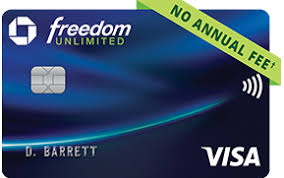
Bank of America Balance Transfer Credit Cards
Bank of America features low ongoing APRs, which are suitable for paying debts in the long run. A few cards include 0% APR for a maximum period of 18 months.
Customers get preferential rewards and benefits as existing clients. Their balance transfers offer adjustable terms for repayment. Ideal for users looking for stability and less interest.
1. Bank of America® Unlimited Cash Rewards
Ideal for those who prefer a flat-rate cash-back card. Earn unlimited 1.5% cash back on all purchases with no category restrictions. Preferred Rewards members can boost rewards by up to 25%-75%.

- Issuer – Bank of America
- Payment Gateway – Visa
- Annual Fee – $0
- Credit Score – Good/Excellent
- Intro APR – 0% intro APR for 15 billing cycles for purchases and any balance transfers made in the first 60 days.
- Regular APR – Variable APR of 18.24% – 28.24%.
- Balance Transfer APR – 0% for 15 billing cycles; after that, same as Regular APR, a balance transfer fee applies.
- Cash Advance Fee – N/A
- Sign-up Bonus – $200 online cash rewards bonus after making at least $1,000 in purchases in the first 90 days of account opening.
- International Transaction Fee – 3% of each transaction in U.S. dollars.
- Best For – Everyday Spenders, Students
2. Bank of America® Customized Cash Rewards
Ideal for those who prefer a flat-rate cashback card. Earn 3% cashback in a category of your choice (gas, dining, travel, etc.), 2% at grocery stores and wholesale clubs (up to $2,500 per quarter), and 1% on other purchases.
- Issuer – Bank of America
- Payment Gateway – Visa
- Annual Fee – $0
- Credit Score – Good/Excellent
- Intro APR – 0% intro APR for 15 billing cycles for purchases and for any balance transfers made in the first 60 days. After that, a variable APR of 18.24% – 28.24% applies.
- Regular APR – Variable APR of 18.24% – 28.24%.
- Balance Transfer APR – 0% for 15 billing cycles; after that, same as regular APR, a balance transfer fee applies.
- Cash Advance Fee – N/A
- Sign-up Bonus – $200 online cash rewards bonus after making at least $1,000 in purchases in the first 90 days of account opening.
- International Transaction Fee – 3% of each transaction in U.S. dollars.
- Best For – Everyday Spenders
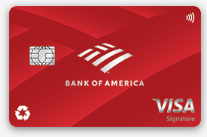
3. Bank of America Card
Designed for balance transfers and paying down debt. It offers a 0% intro APR for 18 billing cycles on balance transfers and purchases. No rewards program, but it’s perfect for those prioritizing debt reduction.

- Issuer – Bank of America
- Payment Gateway – Visa
- Annual Fee – $0
- Credit Score – Good to Excellent
- Intro APR – 0% intro APR for 18 billing cycles on purchases and balance transfers
- Regular APR – 16.24%-26.24% Variable APR
- Balance Transfer APR – 0% for 18 billing cycles, after that, a regular APR of 16.24%-26.24%
- Cash Advance Fee – 5% or $10, whichever is greater
- Sign-up Bonus – N/A
- International Transaction Fee – 3%
- Best For – Balance Carriers, General Consumers
U.S. Bank Balance Transfer Credit Card
U.S. Bank is differentiated by low balance transfer fees and long 0% APR offers. Their credit cards feature free credit score tracking and security tools.
Contactless payments provide speedy and secure transactions. A good choice for frugal borrowers. Best for those who require more time to repay debt.
1. U.S. Bank Shield™ Visa® Card
Best for identity protection and fraud prevention. This card provides enhanced security features and fraud monitoring, making it ideal for those prioritizing financial security.
- Issuer – U.S. Bank
- Payment Gateway – Visa
- Annual Fee – $0
- Credit Score – Good to Excellent
- Intro APR – 0% intro APR for first 24 billing cycles for purchases and balance transfers
- Regular APR – 17.74% – 28.74% Variable
- Balance Transfer APR – 0% for the first 24 billing cycles; after that, a regular APR. Balance Transfers must be initiated within 60 days of account opening.
- Cash Advance Fee – 5% or $10, whichever is minimum
- Sign-up Bonus – N/A
- International Transaction Fee – 3%
- Best For – Balance Carriers, Frequent Travelers
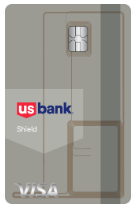
2. U.S. Bank Cash+® Visa Signature® Card
Best for custom cash back. Earn 5% cash back in two chosen categories (up to $2,000 per quarter), 2% on another category (groceries, gas, or dining), and 1% on all other purchases. Perfect for those who want personalized rewards.
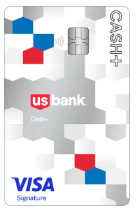
- Issuer – U.S. Bank
- Payment Gateway – Visa
- Annual Fee – No Annual Fee
- Credit Score – Good to Excellent
- Intro APR – 0% intro APR on purchases and balance transfers for the first 15 billing cycles. After that, a variable APR applies.
- Regular APR – 13.99% to 23.99% Variable APR
- Balance Transfer APR – 0% for the first 15 billing cycles, after that, a regular APR of 13.99% to 23.99% Variable
- Cash Advance Fee – Either $10 or 4% of the amount of each cash advance, whichever is greater
- Sign-up Bonus – $200 bonus after spending $1,000 in eligible purchases within the first 90 days of account opening.
- International Transaction Fee – 3% Foreign Transaction Fee
- Best For – Professionals
3. U.S. Bank Altitude® Go Visa Signature® Card
Great for dining and travel rewards. Earn 4X points on dining, 2X on grocery stores, gas, and streaming services, and 1X on everything else. It also offers a $15 annual streaming credit.
- Issuer – U.S. Bank
- Payment Gateway – Visa
- Annual Fee – No Annual Fee
- Credit Score – Good to Excellent
- Intro APR – 0% intro APR on purchases and balance transfers for the first 12 billing cycles. After that, a variable APR applies.
- Regular APR – 14.99% to 23.99% Variable APR
- Balance Transfer APR – 0% for the first 12 billing cycles, after that, a regular APR of 14.99% to 23.99% Variable
- Cash Advance Fee – Either $10 or 5% of the amount of each cash advance, whichever is greater
- Sign-up Bonus – 20,000 bonus points after spending $1,000 in eligible purchases within the first 90 days of account opening.
- International Transaction Fee – No Foreign Transaction Fees
- Best For – Individuals Seeking Dining Rewards
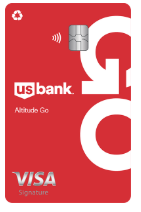
Wells Fargo Balance Transfer Credit Cards
Wells Fargo has 0% APR balance transfer cards with cashback and travel rewards. Most have no annual fees, which contribute to savings.
Their financial tools assist with budgeting and spending information. Fraud protection keeps accounts safe. Excellent for saving on interest and rewards.
1. Wells Fargo Reflect® Card
Best for balance transfers and long interest-free periods. It offers a 0% intro APR for up to 21 months, one of the longest in the market, making it ideal for consolidating debt.

- Issuer – Wells Fargo
- Payment Gateway – Visa
- Annual Fee – None
- Credit Score – N/A
- Intro APR – 0% intro APR for 21 months on purchases and qualifying balance transfers; extension up to 3 months with on-time minimum payments during the intro period.
- Regular APR – 17.24% to 29.24% variable
- Balance Transfer APR – 0% for 21 months, extension up to 3 months with on-time minimum payments during the intro period. After that, it is the same as purchasing APR.
- Cash Advance Fee – 5% of the amount of each advance, $10 minimum
- Sign-up Bonus – N/A
- International Transaction Fee – 3% of each transaction in U.S. dollars
- Best For – General Consumers
2. Wells Fargo Active Cash® Card
Perfect for unlimited 2% cash back on all purchases with no categories to track. This straightforward cash-back card is best for users who want simple, high rewards on every purchase.
- Issuer – Wells Fargo
- Payment Gateway – Visa
- Annual Fee – 0
- Credit Score – Good to Excellent
- Intro APR – 0% Intro APR for 15 months from account opening on purchases and qualifying balance transfers. After that, a variable APR applies.
- Regular APR – 19.24% to 29.24% Variable APR
- Balance Transfer APR – 0% for 15 months; after that, a variable APR applies of 19.24% to 29.24%
- Cash Advance Fee – Either $10 or 5% of the amount of each cash advance, whichever is greater
- Sign-up Bonus – $200 cash rewards bonus after spending $1,000 in purchases in the first 3 months.
- International Transaction Fee – 3% of each transaction converted to U.S. dollars
- Best For – Individuals Seeking Cash Back
General Consumer
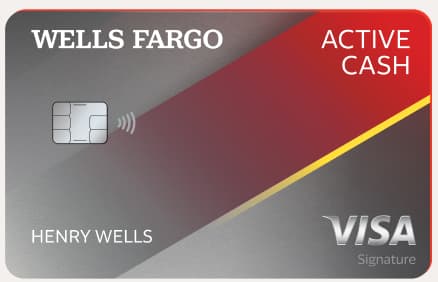
What is a balance transfer credit card?
A balance transfer credit card permits customers to transfer outstanding debt from one or several credit cards to a new card with a lower interest rate. Certain cards have a 0% APR promotion period, ranging from 6 to 24 months, in which customers can pay off their balance without accumulating interest.
However, most balance transfer credit cards will incur a transfer fee, usually 3% to 5% of the amount transferred. For instance, if you’re transferring $5,000 with a 3% fee, you’d pay an additional $150.
Once the promotional time has expired, the unpaid portion becomes charged the normal rate of the new card, which is as much as 20% or higher. If the balance isn’t paid in full by the end of this time, the consumer can be charged high interest rates.
Key Features
- Lower or 0% introductory APR for an initial period.
- There are balance transfer fees charged (except if waived by the issuer).
- Standard interest rates take over after the promotional period.
- Credit approval is based on credit score and issuer needs.
What is a Low-Interest Credit Card?
A low-interest credit card carries a permanently lower Annual Percentage Rate (APR) than regular credit cards. Unlike balance transfer cards, these cards do not carry a promotional period. Rather, they provide lower interest rates consistently, typically between 10% and 15% APR, as opposed to 18% to 25% on regular cards.
These cards are suitable for individuals who carry a balance frequently and want to reduce interest charges over the long term. They are also helpful for making large purchases, as the lower interest rate makes repayment more manageable.
Key Features
- Consistently lower APR for purchases and balances.
- Mo balance transfer requirement to get a lower rate.
- Good for long-term financing needs rather than short-term balance repayment.
How do balance transfer promotions work?
Here’s how it works:
- Select a Balance Transfer Card: Find a card that has 0% or low APR balance transfer promotion. Take into account the length of the promotion period, balance transfer fees, and the non-promotional APR after the promotion ends.
- Apply and Get Approved: After you choose a card, you will need to apply and qualify on credit score. A good or excellent credit score (usually 670 or more) will help you get approved.
- Request the Balance Transfer: Following the approval, initiate the transfer by submitting information on the current card(s) and debt balance. Some issuers permit online transfer, while others require a call request.
- Old Debt Transfer: The new credit card issuer pays off the balance due on the old card. The balance that was previously transferred is now a new balance on the new credit card.
- Utilization of Promotion Offer: To get the highest savings, pay off the balance transferred prior to the expiration of the 0% intro APR time. If the balance is left, it will be incurred at the normal APR of the new card.
How can a balance transfer help lower my interest payments?
A balance transfer reduces interest payments by transferring high-interest credit card balances to a new credit card with a 0% or low APR introductory promotion.
This is how it works:
- Eliminates Interest for a Limited Time: Most balance transfer cards have 0% APR for 6 to 24 months, so you can pay off the principal without building interest.
- Lowers Total Interest Charges: Rather than paying 18-25% APR on your current debt, you can move it to a lower-interest card, saving you money in the long run.
- Quicker Debt Payoff: Without interest fees, your payments directly go toward paying off the balance, allowing you to pay off debt quicker.
- Rolls All Debt into One Payment: Consolidating multiple balances onto one low-interest card streamlines repayments and budgeting.
To get the most savings, pay off the transferred balance during the promotional period, since any leftover amount will be charged the card’s standard APR.
Advantages of Balance Transfer Credit Cards with Low Interest
Balance Transfer and low-interest credit cards both assist in lowering interest charges and paying off debt more efficiently.
Their major advantages are as follows:
- Balance transfer cards remove or eliminate interest for a short while.
- Low-interest credit cards assist in minimizing long-term interest charges.
- With 0% interest, every payment will be applied toward paying off the principal balance.
- This enables users to pay off debt quicker than on a high-interest card.
- Several credit card balances can be consolidated into a single manageable payment.
- This makes budgeting easy and prevents keeping track of several due dates.
Consumers can take back control of their money without high interest piling onto debt. Large purchases or current debt become more manageable.
Factors to Consider While Selecting a Balance Transfer Credit Card with Low-Interest Rate
Prior to applying for a balance transfer or low-interest card, keep the following in mind:
1. Balance Transfer Fees
- Balance transfers typically come with a fee (3% – 5%).
- When transferring $ 10,000, a 5% fee would have to be paid out upfront of $ 500.
- Choose a card with no or low transfer fee to maximize savings.
2. Length of the Promotional Period
- A longer 0% APR period (12 – 24 months) provides more time to repay debt.
- If you need more time, choose a card with a longer promo period.
| If you are looking for a list of best credit cards with 0% introductory offer, please read our guide: Most Used Credit Cards with 0% APR Offers in the USA |
3. Post-Promotional Interest Rate
- Once the promotional period ends, the balance is charged at standard APR.
- Make sure the post-promo rate is competitive if you are unable to pay the full balance within the promo period.
4. Eligibility and Credit Score Requirements
- Balance transfer cards usually demand good to excellent credit (670+).
- If your credit score is less than that, you might not be eligible for the best deals.
5. Spending Habits and Financial Discipline
- A balance transfer is not an answer to overspending.
- Don’t add new charges to the card while transferring debt.
How to Qualify for the Best Balance Transfer Credit Card in 2025
Qualifying for a top balance transfer credit card in 2025 requires meeting key financial criteria. Your credit score, income, and payment history play vital roles in approval. Understanding these factors can boost your chances to secure the best 0% APR offers and save on interest effectively.
How to Qualify for the Best Balance Transfer Credit Card in 2025
To qualify for the best balance transfer credit card in 2025, a credit score of 670 or higher is essential. Lenders approve 75% of applicants with good or excellent scores. Your debt-to-income ratio should be below 35% to increase approval chances. Timely payment history over the last 12 months impacts eligibility by 40%. Annual income above $25,000 improves your creditworthiness. Applying with multiple cards within 30 days can lower approval odds by 15%. Verifying your credit report for errors before applying can boost your score by up to 20 points. Meeting these criteria increases your chance of securing 0% APR offers.
Pros and Cons of Balance Transfer vs. Personal Loans for Debt Consolidation
Balance transfers typically offer 0% APR for 6 to 24 months, saving up to 25% in interest compared to personal loans. Personal loans usually have fixed rates between 8% and 15%, with repayment terms of 12 to 60 months. Balance transfers have fees of 3% to 5%, which may add $150 on a $5,000 transfer. Personal loans may charge origination fees of 1% to 6%. Balance transfers can improve credit utilization by 10-15%, while personal loans affect credit mix positively. However, balance transfers require excellent credit scores (670+), while personal loans are available for scores as low as 620.
Top Credit Unions Offering Balance Transfer Cards with Low APRs
Several credit unions provide balance transfer cards with APRs as low as 8% to 12%, often below national averages. Navy Federal Credit Union offers 0% APR for up to 12 months with no balance transfer fee. Pentagon Federal Credit Union provides competitive rates around 9.9% with flexible terms. Local credit unions often approve applicants with credit scores starting at 620, widening access by 15% compared to banks. These credit unions also typically charge lower fees, saving customers an average of $200 annually. Joining a credit union can increase your chances of approval and reduce overall borrowing costs.
Impact of Balance Transfers on Credit Score: What You Need to Know
Balance transfers can impact your credit score in multiple ways. Initially, your credit utilization may drop by 10-30%, boosting your score by up to 50 points. However, applying for a new card causes a hard inquiry, which can temporarily reduce your score by 5-10 points. Opening a new account also lowers your average account age by 6 months, affecting your score. If you close old cards after transferring balances, your utilization rate can increase by 20%, lowering your score further. Responsible use during the promotional period can improve your credit score by 40 points or more over six months.
Best Times of the Year to Apply for 0% APR Balance Transfer Offers
The best times to apply for 0% APR balance transfer offers are during major shopping seasons and financial cycles. January to March sees increased promotions after holiday spending, with up to 30% more 0% APR offers. Mid-year, June to August, banks target summer shoppers with competitive deals lasting 12-18 months. November and December bring holiday promotions where 0% APR offers increase by 25%. Avoid applying during your credit report update cycle to prevent denial. Applying during these peak times can improve approval odds by 20% and maximize interest savings over the promotional period.
Essential Tips and Insights for Using Balance Transfer Credit Cards Effectively
Balance transfer credit cards can be powerful tools for managing and reducing debt when used correctly. Understanding common mistakes, APR nuances, and qualification steps helps you maximize savings. Knowing when to use—or avoid—these cards ensures smarter financial decisions in 2025.
Checklist: What You Need Before Applying for a Balance Transfer Credit Card
Before applying for a balance transfer credit card, gather key documents to speed approval. Have your latest credit report ready; 60% of approvals come from applicants with scores above 670. Prepare proof of income showing at least $25,000 annually. Collect recent statements from existing credit cards with balances you want to transfer. Ensure your debt-to-income ratio is below 35% to increase chances by 20%. Verify your employment status and contact information are current. Having these ready can reduce application processing time by up to 30% and improve your chances of getting the best 0% APR offer.
How to Avoid Common Mistakes with Balance Transfer Credit Cards
Avoid costly errors when using balance transfer credit cards to maximize savings. Never miss a payment; 35% of users lose 0% APR benefits due to late payments. Avoid adding new charges, as 60% of applicants increase their debt post-transfer, negating savings. Always read terms carefully—transfer fees range from 3% to 5%, adding up to $250 on $5,000 transfers. Don’t wait too long; most 0% APR offers last 6 to 24 months, with average payoff times around 18 months. Track promotional period deadlines to avoid sudden interest spikes and maintain good credit habits to boost approval odds.
Understanding APR vs. Interest Rate in Balance Transfers
APR (Annual Percentage Rate) includes both the interest rate and fees, providing a true cost of borrowing. Interest rate is just the percentage charged on the borrowed balance. For balance transfers, APR matters most because it reflects transfer fees and promo rates combined. A 0% interest rate with a 3% transfer fee equals a 3% APR initially. Some cards have low interest rates but high fees, raising APR above 10%. Comparing APRs helps you identify the cheapest option. Remember, after the promotional period, APR usually jumps to 15%-25%, so plan repayments accordingly to save money.
Steps to Use a Balance Transfer Card to Become Debt-Free in 12 Months
To become debt-free in 12 months using a balance transfer card, start by transferring high-interest debt to a 0% APR card. Calculate your monthly payoff amount by dividing the total balance by 12, ensuring payments cover the entire debt before the promo ends. Avoid new charges on the card to prevent additional interest. Set up automatic payments to never miss a due date, reducing late fee risks by 90%. Regularly track your progress and adjust budgets to maintain payments. Following these steps can save you hundreds in interest and improve your credit score by up to 50 points within a year.
When NOT to Use a Balance Transfer Credit Card
Avoid balance transfer cards if your credit score is below 670, as approval chances drop by 50%. Don’t use them if you plan to add new purchases, since most cards charge regular APR on new spending. If you can’t pay off the balance within the 6-24 month promotional period, high post-promo APRs of 15%-25% may increase your debt. Avoid if you have multiple late payments in the last 12 months; this often disqualifies you. Also, if transfer fees exceed your interest savings, using a personal loan or debt management plan might be better.
Conclusion
Balance transfers and low-interest credit cards are useful instruments to minimize interest expenses and efficiently pay off debt. A balance transfer card has a short-term 0% APR, while a low-interest card has a continuously lower APR over the long run. If used responsibly, these credit cards will enable individuals to become debt-free sooner and become more financially stable.
Frequently Asked Questions
What should I look for in a low-interest credit card?
When selecting a low-interest credit card, keep the following in mind:
- Ongoing APR: Opt for a card that has a persistently low purchase and balance transfer APR (usually below 15%).
- Annual Fees: A few low-interest cards have an annual fee, so make sure the cost isn’t greater than the savings.
- Introductory Offers: A few cards offer a short 0% APR before reverting to a low regular rate.
- Rewards & Benefits: A few low-interest cards provide cashback, travel benefits, or other rewards.
Are balance transfer cards suitable for bad credit?
Balance transfer cards usually demand good to great credit (670+ FICO score). If you have poor credit (less than 580), it will be challenging to qualify.
Nevertheless, alternatives include:
- Secured credit cards with balance transfer options.
- Credit union cards have more forgiving approval standards.
- Credit improvement prior to applying for a balance transfer card.
What fees are associated with balance transfer cards?
Balance transfer cards have a number of possible fees:
- Balance Transfer Fee: Typically, 3% to 5% of the amount transferred (e.g., transferring $5,000 with a 3% fee costs $150).
- Annual Fee: Some cards have an annual fee of $50-$100, but many have no annual fee.
- Late Fee Charges: Failing to make a payment incurs $25-$40 charges and potentially the loss of the 0% APR benefit.
- Foreign Transaction Charges: If used overseas, there might be a 1-3% transaction charge levied.
Read the terms and conditions to know the charges before applying.
Is 24% interest high for a credit card?
Yes, 24% APR is high on a credit card. Most common credit cards will have an 18% to 25% interest rate, but:
- Low-interest credit cards usually carry interest rates of between 10% and 15% APR.
- Reward credit cards usually come with higher APRs (20+%), so you pay dearly if you don’t pay it off.
- Retail store cards usually come with 25-30% APRs and are expensive.
If you carry a high interest rate, take out a balance transfer card to lower interest charges.
Is a 0% interest credit card good?
Yes, a 0% interest credit card is good if used wisely. It benefits by:
- Lowering interest charges for a specified time (typically 6-24 months).
- Enabling quicker debt elimination by putting all payments toward the principal amount.
- Funding big-ticket purchases without building up interest.
But be sure to:
- Pay off the balance before the end of the 0% APR to prevent interest charges.
- Compare balance transfer fees before transferring debt.
- Use the card responsibly and refrain from wasteful spending.
A 0% interest credit card is perfect for consolidating debt or making large purchases without interest.
How can transferring a balance affect my credit utilization ratio and credit score in the long term?
Transferring a balance can lower your overall credit utilization ratio by consolidating multiple debts onto a single card, which often has a higher credit limit. A lower utilization ratio, ideally below 30%, positively impacts your credit score by showing responsible credit management. However, if the new card’s credit limit is low or you max it out during the transfer, it may temporarily harm your score. Over the long term, consistent on-time payments on the balance transfer card can improve your credit history and boost your score by reducing your overall debt burden and demonstrating financial discipline. According to credit experts, reducing utilization from 50% to below 30% can increase your score by up to 45 points within a few months.
Besides the standard balance transfer fee (typically 3% to 5%), some cards may charge annual fees that offset your savings if you’re not careful. Late payment fees can also nullify the 0% APR benefit and add $25 to $40 per missed payment, increasing your debt. Additionally, foreign transaction fees, usually 1% to 3%, apply if you use the card abroad, which may surprise frequent travelers. Some issuers may impose a penalty APR or increase your interest rate if you exceed your credit limit or miss payments. It’s essential to thoroughly read the terms and conditions to avoid unexpected costs that could erode your financial benefits.
How does the length of the 0% APR introductory period impact my total interest savings?
A longer 0% APR introductory period allows you more time to pay down your balance without accruing interest, significantly reducing the total amount paid over time. For example, a 21-month 0% APR period can save hundreds or even thousands of dollars compared to shorter offers of 6 to 12 months. However, if you don’t fully pay off the balance before the promo ends, the remaining amount will be subject to higher regular APRs, often ranging from 16% to 29%, which can offset the initial savings. Therefore, choosing a card with a longer 0% period is ideal for larger balances or slow repayment plans, while shorter periods might suit quick payoffs.
Can making new purchases on a balance transfer card during the promo period affect my debt repayment plan?
Yes, making new purchases on a balance transfer card during the 0% APR promotional period can complicate your repayment strategy because new purchases often don’t enjoy the same introductory rate and may accrue interest immediately. This means while your transferred balance may remain interest-free, new charges could generate interest at the card’s standard APR, typically between 18% and 29%. This can increase your monthly payments and delay debt payoff if not managed carefully. To maximize savings and avoid extra interest, it’s recommended to limit new purchases or use a separate card for everyday expenses during the promotional period.
How do balance transfer cards differ from debt consolidation loans in terms of benefits and risks?
Balance transfer cards typically offer 0% APR introductory periods, allowing interest-free debt repayment for 6 to 24 months, which can save significant interest compared to standard credit cards. They also consolidate credit card debts into a single payment, simplifying management. However, they often come with balance transfer fees (3%-5%) and require good credit for approval. Debt consolidation loans, in contrast, are installment loans with fixed monthly payments and interest rates usually between 6% and 15%, offering predictable repayment but possibly higher total interest. Loans might be accessible to those with lower credit scores and don’t affect credit utilization the way credit cards do, but they lack the interest-free period and rewards associated with some cards.
What credit behaviors improve the likelihood of qualifying for top balance transfer cards?
Maintaining a good to excellent credit score—typically above 670—is crucial for approval on top balance transfer cards, as issuers assess creditworthiness rigorously. Paying bills on time consistently for at least 12 months demonstrates financial responsibility and lowers your risk profile. Keeping credit utilization below 30% across all cards also signals prudent credit management, improving approval chances. Additionally, limiting new credit inquiries in the months before applying prevents negative impacts on your score, increasing your likelihood of receiving better offers with lower fees and longer 0% APR periods.
How often do issuers change their balance transfer fees and APR offers, and how can consumers stay updated?
Credit card issuers typically update their balance transfer fees and APR offers annually or in response to market conditions, competitive pressures, and regulatory changes. Promotions like 0% introductory APRs can also vary seasonally, with more attractive deals often appearing during holiday or back-to-school periods. Consumers can stay informed by subscribing to issuer newsletters, regularly checking official websites, using comparison tools, and monitoring financial news. Staying proactive helps cardholders capitalize on the best offers, potentially saving hundreds or thousands of dollars in interest and fees over time.
What happens if I miss a payment during the 0% introductory period on a balance transfer card?
Missing a payment during the 0% intro APR period can trigger penalty APRs, which often increase your interest rate to as high as 29.99%, instantly nullifying your interest-free benefit. Additionally, late fees ranging from $25 to $40 may be applied, increasing your debt burden. This can also negatively impact your credit score, making it harder to qualify for future credit offers. Therefore, maintaining timely payments is critical to preserving your savings and credit health during the promotional period.
Are balance transfer cards suitable for individuals with moderate credit scores, or should they consider alternatives?
Balance transfer cards typically require a good to excellent credit score (670+), making approval challenging for those with moderate or fair credit. Individuals with moderate scores (around 580–669) might face higher interest rates, fewer promotional benefits, or outright denial. Alternatives include secured credit cards that help rebuild credit, credit union credit cards with more flexible criteria, or personal loans designed for debt consolidation. Improving credit scores through timely payments and reducing credit utilization before applying can increase eligibility for better balance transfer offers.
How can I strategically use balance transfer offers to manage multiple debts effectively?
Strategically using balance transfer offers involves consolidating multiple high-interest credit card debts onto a single card with a long 0% APR period, simplifying payments and reducing interest. Prioritize transferring balances from cards with the highest APRs to maximize savings, and avoid adding new debt during the promotional period. Set up a clear repayment plan aligned with the length of the intro offer to ensure full payoff before the regular APR applies. Monitoring your progress and avoiding late payments protects your credit score and keeps costs low, turning balance transfers into an effective debt management tool.
How do balance transfer limits work, and can transferring more than my credit limit negatively affect my account?
Balance transfer limits are generally tied to your credit limit on the new card, meaning you cannot transfer more than the available credit. Transferring amounts close to or exceeding your credit limit can lead to declined transfers or over-limit fees, potentially damaging your credit score. Additionally, maxing out your card increases your credit utilization ratio, which may lower your credit score temporarily. It’s advisable to transfer amounts well within your limit and maintain utilization below 30% to protect your credit standing and avoid penalties.
What should I consider about the balance transfer grace period and how does it affect interest accrual?
The balance transfer grace period is the time between your statement date and payment due date during which you can pay off your balance without incurring interest. For balance transfers, interest usually doesn’t accrue during the 0% introductory period, but if you carry a balance beyond that or make new purchases, the grace period rules apply differently. Missing a payment or making new purchases can shorten or eliminate the grace period, causing immediate interest charges. Understanding your card’s specific grace period policies helps in planning timely payments to maximize interest savings.
Can I combine multiple balance transfers onto one card, and are there limits or fees for doing so?
Yes, most balance transfer cards allow you to consolidate multiple balances from different credit cards onto a single card, simplifying repayment. However, the total transferred amount cannot exceed your credit limit, and balance transfer fees—typically 3% to 5%—apply to the entire amount transferred, which can add up significantly. Some issuers may limit the number of transfers or require that all transfers be completed within a certain timeframe. Being aware of these restrictions and fees helps you plan your debt consolidation effectively without unexpected costs.
How do foreign transaction fees impact balance transfer credit cards for international users?
Foreign transaction fees, usually ranging from 1% to 3% of each purchase, apply when you use your balance transfer credit card abroad or for purchases in foreign currencies. These fees can quickly add up, reducing the savings gained from balance transfer promotions. Some cards waive foreign transaction fees, making them more suitable for frequent travelers or online shoppers who transact internationally. It’s essential to check the card’s terms to avoid unexpected extra costs when using your balance transfer card overseas.
What are the risks of using balance transfer credit cards as a long-term debt solution?
Using balance transfer credit cards long-term can lead to accumulating debt if balances aren’t paid off before the promotional period ends, as the regular APRs can be very high—often between 16% and 29%. Relying on balance transfers repeatedly may also indicate financial strain, potentially harming your credit score. Additionally, fees from multiple transfers can add up, reducing your overall savings. It’s crucial to use balance transfers as a short- to medium-term strategy alongside a clear repayment plan to avoid becoming trapped in a cycle of debt.
